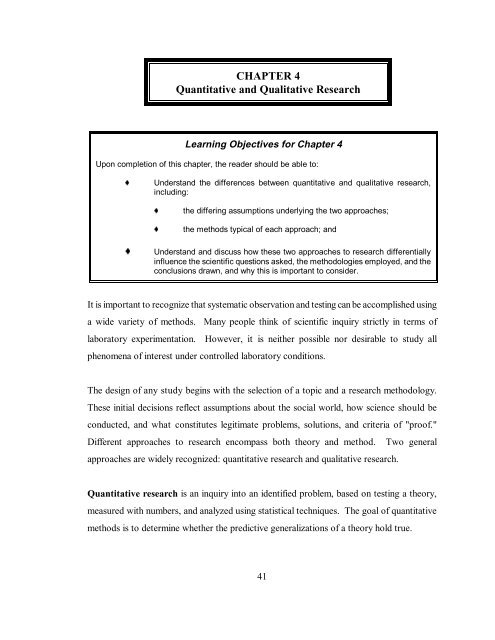CHAPTER 4 Quantitative and Qualitative Research - Chnri
CHAPTER 4 Quantitative and Qualitative Research - Chnri
CHAPTER 4 Quantitative and Qualitative Research - Chnri
You also want an ePaper? Increase the reach of your titles
YUMPU automatically turns print PDFs into web optimized ePapers that Google loves.
<strong>CHAPTER</strong> 4<br />
<strong>Quantitative</strong> <strong>and</strong> <strong>Qualitative</strong> <strong>Research</strong><br />
Learning Objectives for Chapter 4<br />
Upon completion of this chapter, the reader should be able to:<br />
d<br />
Underst<strong>and</strong> the differences between quantitative <strong>and</strong> qualitative research,<br />
including:<br />
d<br />
d<br />
the differing assumptions underlying the two approaches;<br />
the methods typical of each approach; <strong>and</strong><br />
d<br />
Underst<strong>and</strong> <strong>and</strong> discuss how these two approaches to research differentially<br />
influence the scientific questions asked, the methodologies employed, <strong>and</strong> the<br />
conclusions drawn, <strong>and</strong> why this is important to consider.<br />
It is important to recognize that systematic observation <strong>and</strong> testing can be accomplished using<br />
a wide variety of methods. Many people think of scientific inquiry strictly in terms of<br />
laboratory experimentation. However, it is neither possible nor desirable to study all<br />
phenomena of interest under controlled laboratory conditions.<br />
The design of any study begins with the selection of a topic <strong>and</strong> a research methodology.<br />
These initial decisions reflect assumptions about the social world, how science should be<br />
conducted, <strong>and</strong> what constitutes legitimate problems, solutions, <strong>and</strong> criteria of "proof."<br />
Different approaches to research encompass both theory <strong>and</strong> method. Two general<br />
approaches are widely recognized: quantitative research <strong>and</strong> qualitative research.<br />
<strong>Quantitative</strong> research is an inquiry into an identified problem, based on testing a theory,<br />
measured with numbers, <strong>and</strong> analyzed using statistical techniques. The goal of quantitative<br />
methods is to determine whether the predictive generalizations of a theory hold true.<br />
41
By contrast, a study based upon a qualitative process of inquiry has the goal of<br />
underst<strong>and</strong>ing a social or human problem from multiple perspectives. <strong>Qualitative</strong> research<br />
is conducted in a natural setting <strong>and</strong> involves a process of building a complex <strong>and</strong> holistic<br />
picture of the phenomenon of interest.<br />
The selection of which research approach is appropriate in a given study should be based<br />
upon the problem of interest, resources available, the skills <strong>and</strong> training of the researcher, <strong>and</strong><br />
the audience for the research. Although some research may incorporate both quantitative <strong>and</strong><br />
qualitative methodologies, in their ‘pure’ form there are significant differences in the<br />
assumptions underlying these approaches, as well as in the data collection <strong>and</strong> analysis<br />
procedures used.<br />
Why is the distinction between quantitative <strong>and</strong> qualitative research important?<br />
It is important to be able to identify <strong>and</strong> underst<strong>and</strong> the research approach underlying any given<br />
study because the selection of a research approach influences the questions asked, the methods<br />
chosen, the statistical analyses used, the inferences made, <strong>and</strong> the ultimate goal of the research.<br />
When critically reviewing scientific research, the questions asked, <strong>and</strong> the answers given, will<br />
differ depending upon whether the research is quantitative or qualitative.<br />
<strong>Quantitative</strong> Methods<br />
Assumptions Underlying <strong>Quantitative</strong> Methods<br />
& reality is objective, “out there,” <strong>and</strong> independent of the researcher -- therefore reality is<br />
something that can be studied objectively;<br />
& the researcher should remain distant <strong>and</strong> independent of what is being researched;<br />
& the values of the researcher do not interfere with, or become part of, the research --<br />
research is value-free;<br />
& research is based primarily on deductive forms of logic <strong>and</strong> theories <strong>and</strong> hypotheses are<br />
tested in a cause-effect order; <strong>and</strong><br />
& the goal is to develop generalizations that contribute to theory that enable the researcher<br />
to predict, explain, <strong>and</strong> underst<strong>and</strong> some phenomenon.<br />
42
Three general types of quantitative methods:<br />
1. Experiments True experiments are characterized by r<strong>and</strong>om assignment of<br />
subjects to experimental conditions <strong>and</strong> the use of experimental controls.<br />
2. Quasi-Experiments Quasi-experimental studies share almost all the features of<br />
experimental designs except that they involve non-r<strong>and</strong>omized assignment of subjects<br />
to experimental conditions.<br />
3. Surveys Surveys include cross-sectional <strong>and</strong> longitudinal studies using<br />
questionnaires or interviews for data collection with the intent of estimating the<br />
characteristics of a large population of interest based on a smaller sample from that<br />
population.<br />
<strong>Qualitative</strong> Methods<br />
Assumptions Underlying <strong>Qualitative</strong> Methods<br />
&<br />
&<br />
&<br />
&<br />
&<br />
&<br />
&<br />
multiple realities exist in any given situation -- the researcher’s, those of the individuals<br />
being investigated, <strong>and</strong> the reader or audience interpreting the results; these multiple<br />
perspectives, or voices, of informants (i.e., subjects) are included in the study;<br />
the researcher interacts with those he studies <strong>and</strong> actively works to minimize the<br />
distance between the researcher <strong>and</strong> those being researched;<br />
the researcher explicitly recognizes <strong>and</strong> acknowledges the value-laden nature of the<br />
research;<br />
research is context-bound;<br />
research is based on inductive forms of logic; categories of interest emerge from<br />
informants (subjects), rather than being identified a priori by the researcher;<br />
the goal is to uncover <strong>and</strong> discover patterns or theories that help explain a phenomenon<br />
of interest; <strong>and</strong><br />
determinations of accuracy involve verifying the information with informants or<br />
"triangulating" among different sources of information (e.g., collecting information from<br />
different sources).<br />
Three general types of qualitative methods:<br />
1. Case Studies In a case study the researcher explores a single entity or<br />
phenomenon (‘the case’) bounded by time <strong>and</strong> activity (e.g., a program, event,<br />
institution, or social group) <strong>and</strong> collects detailed information through a variety of data<br />
43
collection procedures over a sustained period of time. The case study is a descriptive<br />
record of an individual's experiences <strong>and</strong>/or behaviors kept by an outside observer.<br />
2. Ethnographic Studies In ethnographic research the researcher studies an intact<br />
cultural group in a natural setting over a specific period of time. A cultural group can<br />
be any group of individuals who share a common social experience, location, or other<br />
social characteristic of interest -- this could range from an ethnographic study of<br />
rape victims in crisis shelters, to children in foster care, to a study of a cultural group<br />
in Africa.<br />
3. Phenomenological Studies In a phenomenological study, human experiences are<br />
examined through the detailed description of the people being studied -- the goal is<br />
to underst<strong>and</strong> the ‘lived experience’ of the individuals being studied. This approach<br />
involves researching a small group of people intensively over a long period of time.<br />
??? Questions to consider when evaluating scientific evidence ...<br />
d<br />
d<br />
d<br />
d<br />
Was a quantitative or qualitative research approach adopted?<br />
Was the research approach appropriate given the problem investigated <strong>and</strong><br />
the goals of the research?<br />
Was the process of investigation consistent with the underlying assumptions<br />
of the research used?<br />
Were appropriate types of conclusions drawn given the research approach<br />
used?<br />
Before going any further, stop <strong>and</strong> reflect ...<br />
d<br />
d<br />
d<br />
What are some examples of quantitative research that<br />
might be proffered as evidence in court?<br />
What are some examples of qualitative research that<br />
might be proffered as evidence in court?<br />
To what extent, if any, would your critical review of these<br />
different types of evidence differ?<br />
44
CRITICAL QUESTIONS REVIEWED<br />
d<br />
d<br />
d<br />
d<br />
Was the quantitative or qualitative approach adopted?<br />
Was the research approach selected appropriate given the problem investigated <strong>and</strong><br />
the goals of the research?<br />
Was the process of investigation consistent with underlying assumptions of the<br />
research approach used?<br />
Were appropriate types of conclusions drawn given the research approached used?<br />
45
GLOSSARY<br />
share almost all the features of experimental designs except that they involve non-<br />
r<strong>and</strong>omized assignment of subjects to experimental conditions<br />
case studies<br />
ethnographic studies<br />
experimental studies<br />
phenomenological<br />
studies<br />
qualitative research<br />
quantitative research<br />
quasi-experimental<br />
studies<br />
r<strong>and</strong>om assignment<br />
survey<br />
the researcher explores a single entity or phenomenon ("the case") bounded by<br />
time <strong>and</strong> activity (e.g., a program, event, process, institution, or social group) <strong>and</strong><br />
collects detailed information through a variety of data collection procedures over<br />
a sustained period of time<br />
the researcher studies an intact cultural group in a natural setting over a specific<br />
period of time; a cultural group can be any group of individuals who share a<br />
common social experience, location, or other social characteristic of interest<br />
characterized by r<strong>and</strong>om assignment of subjects to experimental conditions <strong>and</strong><br />
the use of experimental controls<br />
human experiences are examined through the detailed description of the people<br />
being studied -- the goal is to underst<strong>and</strong> the "lived experience" of the individuals<br />
being studied; involves studying a small group of people intensively over a long<br />
period of time<br />
a process of inquiry with the goal of underst<strong>and</strong>ing a social or human problem<br />
from multiple perspectives; conducted in a natural setting with a goal of building<br />
a complex <strong>and</strong> holistic picture of the phenomenon of interest<br />
an inquiry into an identified problem, based on testing a theory composed of<br />
variables, measured with numbers, <strong>and</strong> analyzed using statistical techniques; the<br />
goal is to determine whether the predictive generalizations of a theory hold true<br />
all subjects have an equal change of being assigned to a given experimental<br />
condition; a procedure used to ensure that experimental conditions do not differ<br />
significantly from each other<br />
questionnaires or interviews for data collection with the intent of generalizing<br />
from a sample population to a larger population of interest<br />
SUGGESTED READINGS<br />
Creswell, J.W. (1994). <strong>Research</strong> Design: <strong>Qualitative</strong> <strong>and</strong> <strong>Quantitative</strong> Approaches. Sage Publications:<br />
Thous<strong>and</strong> Oaks, CA.<br />
Mason, J. (1996). <strong>Qualitative</strong> <strong>Research</strong>. Thous<strong>and</strong> Oaks: Sage Publications.<br />
46
-XGJH·V1RWHV<br />
47

















